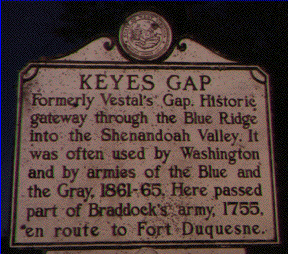
Like most roads, Vestal's Gap Road probably started out as an animal trail along a natural ridge running parallel to the present Potomac River. Such trails were also used by Indians long before explorers and settlers arrived. Settlers began arriving in greater numbers into Virginia's Northern neck, the Shenandoah Valley and eastern Ohio after an agreement between the militia and the Indians in 1772.
Vestal's Gap Road ran from Alexandria to present day Leesburg and on to Winchester. It was probably named after John Vestal, who ran a ferry at the point where Rt. 9 now crosses into the Blue Ridge Mountains. It has also been referred to, at various times, as the Eastern Ridge Road, Keys Gap Road, and, by George Washington, the Great Road. Between 1753-1799, Washington traveled along this route on various military, business and personal journeys. George Washington's military missions over the road between 1753-1755 are well documented, and so was its use by troops under the command of General Braddock en route to the ill-fated campaign against the French at Fort Duquesne (located near present-day Pittsburgh).
It has been thought that the majority of Braddock's troops had followed the Maryland route, which had been taken by the General himself. Later research, most notably by historian General William D. Craighill, shows that most of the troops followed the Virginia route using Vestal' Gap Road. Among the troops following this route were the 44th. Foot, or Grenadiers, commanded by Sir Peter Halkett. The 44th. Foot were later to take the brunt of the French and Indian ambush near Fort Duquesne. Other troops traversing this road were the Royal Artillery, under the command of Lt. Col. Thomas Gage, who later became the Commanding General of British troops in America, and led the unit that clashed with Revolutionary forces at Lexington and Concord. Also following this route were the 3rd. South Carolina Independent Company, the 3rd. And 4th. New York Independent Companies and North Carolina Troops. Kentucky Frontiersman, Daniel Boone was among the N.C. troops. Col. George Washington, commanding the Virginia Regiment, also took the Vestal's Gap Road. He knew the rout well from his prior expeditions and had recommended it to Gen. Braddock, but his advice was not fully headed. The 48th. Foot under the command of Dunbar, followed the Maryland rout, but had to recross the Potomac at Williamsport and continue on the Virginia side to Winchester, where the 44th. Foot were already camped. From here the troops headed to Ft. Cumberland and on to Fort Duquesne, where General Braddock was defeated and lost his life. His troops were almost completely destroyed with the remnants being led to safety by George Washington
By the beginning of the Nineteenth Century, the building of turnpikes such as the Little River Turnpike, the Georgetown- Leesburg Pike and the Alexandria-Leesburg Pike meant that Vestal's Gasp Road was no longer relied on so heavily. The road became less used and now only very small sections of the original "Great Road" remain. The stretch running through Claude Moore Park in Sterling is one of the few remaining parts of this vital colonial road. Its historic value was summarized well by historian Fairfax Harrison in his definitive work, Landmarks of Old Prince William: "This road early played a pert in American History. More justly than other Fairfax road which runs via Centreville, it is known in the Hillsboro neighborhood as 'Braddocks's Road'. If it never knew the chariot of General Edward Braddock himself, a brigade of his troops marched over it; and yet it might with more propriety be called the 'Washington Road', for the father of this county used it frequently; conspicuously in public service of his expeditions to Fort DuQuesne in 1753 and again the following year when he marched in command of the Virginia Regiment."
Local historians, preservationists and community groups are currently seeking government funds to aid in the preservation and restoration of this stretch of the road
We would like to acknowledge Carl F. MacIntyre of Sterling for his painstaking research and dedication to the conservation and recognition of this landmark road. If you would like to know more on this subject, or would like to lend your support to the campaign to keep this road intact, please stop by the visitor's center for further information.
Thank you for visiting Claude Moore Park
Jessica L. Aliff Girl Scout Troop 1385 July 4, 1995
Return to main page.